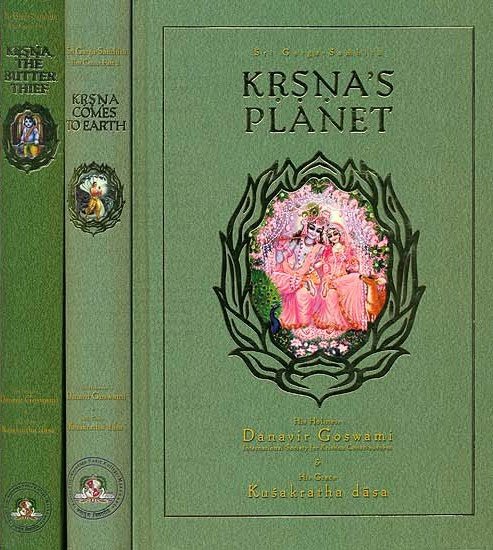Garga Samhita (English)
by Danavir Goswami | 425,489 words
The Garga-samhita Verse 1.1.16, English translation, including word-by-word: This text represents a Vaishnava scripture which narrates the life Krishna, It was composed in seventeen cantos by Garga Muni: an ancient sage and priest of the Yadu dynasty having. This is verse 1 of Chapter 1 (Description of Shri-Krishna’s Glories) of Canto 1 (goloka-khanda).
Verse 1.1.16
Sanskrit text, transliteration and word-by-word meaning:
श्री-नारद उवाच
अंशांशो ऽंशस् तथावेशः
कला पूर्णः प्रकथ्यते
व्यासाद्यैश् च स्मृटः षष्ठः
परिपूर्णतमः स्वयम्
śrī-nārada uvāca
aṃśāṃśo 'ṃśas tathāveśaḥ
kalā pūrṇaḥ prakathyate
vyāsādyaiś ca smṛṭaḥ ṣaṣṭhaḥ
paripūrṇatamaḥ svayam
śrī-nārada uvāca—Śrī Nārada said; aṃśa—of a part; aṃśaḥ—of a part; aṃśaḥ—a part; tathā—then; āveśaḥ—entrance; kalā—a part; pūrṇaḥ—full; prakathyate—is said; vyāsa-ādyaiś—by they who have Vyāsa as their leader; ca—also; smṛṭaḥ—remembered; ṣaṣṭhaḥ—six; paripūrṇatamaḥ—most full; svayam—personally.
English translation of verse 1.1.16:
Śrī Nārada said: In the Smṛti-śāstra the great sages who have Vyāsa as their leader explain that the Lord descends in six kinds of forms: 1. aṃśāṃśa (a part of a part), 2. aṃśa (a part), 3. āveśa (entrance into a jīva), 4. kalā (a full part), 5. pūrṇa (full), and 6. paripūrṇatama (most full).
